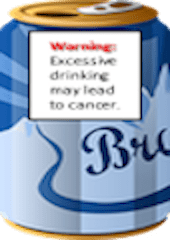
A caution (e.g., drink responsibly) or warning (e.g., may cause cancer) does not have a universally accepted definition. It is usually associated with labelling that appears on a product (on-product), within product packaging, or at the product’s place of use. Alcohol labelling policies vary across the world with some form of labelling currently mandatory in 31 countries. Over the last few years there has been an upsurge in interest regarding the potential benefits that may be gained for consumers if health warnings on alcohol products were mandatory in the UK. Coupled with this interest there has been government action to include the possibility of health warnings on products as part of all-party manifestos. However research in the field of alcohol labelling has not kept pace with that of research in the field of tobacco control and as such the overall understanding of whether or not alcohol warning labels might deter excessive consumption is limited. As a result, Hassan and Shiu been funded by the British Academy to undertake a project to investigate the efficacy of alcohol warning labels.
Hassan & Shiu’s research aims to assess the potential of alcohol warning labels to encourage responsible drinking by undergraduate students in the UK. Students are a key group because in any one year about 20% of students meet the criteria for problem drinking. The project has explored the types of messages that may be accepted by the target population, assessing how a number of messages across health and social themes might affect students in changing their views, attitudes, and behaviour. The research sought to explore the potential efficacy of pictorial over text-based warnings using experimental methods as well as understanding the underlying process that results in any change in attitudes or behaviour.
The project comprises two main phases:
The first phase used focus groups to explore reactions to different warning labels in terms of content, design, message, use of visuals and sought ideas from participants on warning labels that they think would/wouldn’t be effective. Effectiveness is explored from different perspectives including: noticeability, believability, persuasiveness, potential defensive responses and behaviour change.
The second phase draws from the findings of the first phase and tests specific warning designs. So far four experiments have been undertaken including a final novel wine pouring experiment. This wine pouring experiment sought to test the most successful warning in a more realistic setting and assess the influence of the warning versus current labelling practice on the amount of actual wine poured.
The project hopes to feed into the policy debate surrounding whether or not alcohol warning labels (particularly in a pictorial format) should be introduced. Further, the project aims to identify which warning messages would be most effective in reducing excessive alcohol consumption amongst students in the UK. A number of newsletters that contain key findings and general information about the project are available at www.alcoholwarninglabels.info. With the growing interest in studies on alcohol warning labelling this project aims to gather wider evidence and provide a clearer picture as to the form, benefits, and potential drawbacks from any introduction of alcohol warning labels.
Written by Louise Hassan, Professor of Consumer Psychology at Bangor Business School.
All IAS Blogposts are published with the permission of the author. The views expressed are solely the author’s own and do not necessarily represent the views of the Institute of Alcohol Studies.
